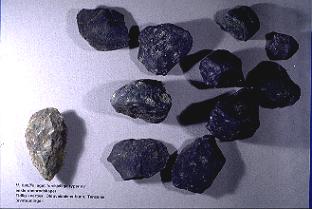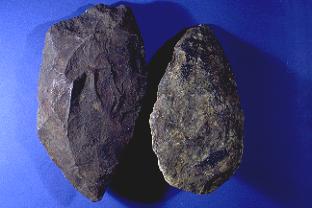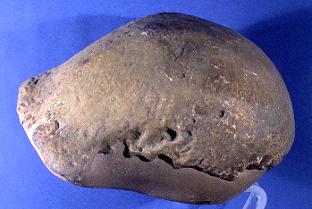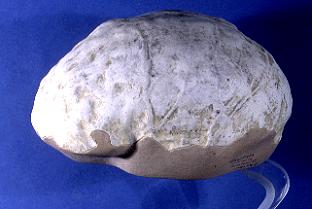With HOMO HABILIS we have the first evidence of BASIC CULTURE in the form of manufactured stone tools. Remember from the last lecture that there may have been tools before this, but none that have been discernible in the archaeological record. Notice also that this is the first critter that we put into our own genus, Homo. This is because Homo habilis is the first bipedal ape to have a significantly increased brain size.
| Homo habilis Tools |  |
Geography:
As with the Australopiths, this early Homo species is restricted to Africa. To date fossil finds have been found in east and southern Africa, including places such as the Olduvai Gorge, where Mary and Louis Leaky spent their lives searching for our ancestors. The fossils date between 2.4 and 1.5 mya. This time span covers the end of the Pliocene and the beginning of the Pleistocene.
Physical Characteristics:
Homo habilis is slightly taller than the Gracile Australopithecines and has a larger brain, about 600-700 cc on average. Her teeth are slightly smaller and more like those of modern humans. She does not have any of the vegetarian dental and cranial structure found in the Robust Australopiths and so is believed to be a descendant of the Gracile Australopiths. Her face is similar to the Gracile Australopithecines, in that it is still very ape like with its projecting jaw.
Culture:
With Homo habilis we see the OLDUWAN tool kit, the first stone tools. These are not like the well crafted stone tools of more recent Homo species; they are simply a stone cobble with a couple flakes knocked off. They are not aerodynamically shaped and so were most likely not used for hunting. They do provide a sharp chopping edge, however.
So how do we distinguish them from rocks that have been broken naturally? Well, we find them in association with bones that have cut marks on them. Because the tools were not refined enough for hunting, we believe these early hominids were scavengers. They probably stole the leftovers from predator (such as, the sabre-tooth tiger) kills.
These clusters of bones are not just single events, but a series of meals brought back to the same place. This may indicate a home base, but it is not until Homo erectus is on the scene, that we have definite proof of settlements and group living.
2. Homo erectus:
 |
Homo erectus |
With Homo erectus there is a big jump in cranial capacity, tools that may have been used for hunting, seasonal shelters, and the use of fire. In Homo erectus see a hominid that is more recognizably human. But the innovations of Homo erectus are still just an expansion of Kroeber's Basic Culture. We still have no evidence of Secondsary Culture, such as , art music, rituals etc.
 |
Homo erectus tools |
Geography:
Homo erectus is the first hominid to leave Africa. She spreads to Europe and goes as far as Southeast Asia. Hominids have not yet populated Australia, the Pacific Islands, or the Americas. Homo erectus appears around 2 million years ago and lasts until about 130 thousand years ago (kya).
| Homo erectus skull cap from Java |  |
Physical Characteristics:
The cranial capacity of Homo erectus is on average around 1050 cc. The head is still very football shaped, but the ape like appearance is less evident. The face of Homo erectus is flatter than that of earlier hominids, giving erectus a slightly more human look. The teeth are smaller and are now within the range of size of modern humans.
| The Endocast (a plaster cast of the brain cavity) of Homo erectus |  |
One hallmark characteristic of Homo erectus is the SAGGITAL KEEL. This is located down the middle of the skull, as was the saggital crest. But it is different from the saggital crest in that it is not a muscle attachment. It is not a sharp crest, but subtle apex at the top of the skull (like the keel of a ship). We are not sure why Homo erectus had a keel or why it is sometimes found in modern populations (Patrick Stewart of Star Trek has a saggital keel).
Postcranilly, Homo erectus is much taller than previous hominids and is well into the range of height for modern humans, with some individuals as tall as 6 feet. Their hand bones are slightly less curved than those of previous hominids, making their hands more dexterous. By looking at the bones of their spine, we can see that their spinal chord was more narrow than ours, indicating less innervation. With less nerves running through her body, erectus' hand-eye coordination was probably not as good as ours.
Culture:
With a much larger brain came an expansion of culture. Homo erectus starts to make tools that are aerodynamic, more functional, and more varied. The Olduwan kit contained only a simple chopping tool. The erectus kit contains a large projectile point (referred to as a hand ax in some of the literature), choppers, and other large cutting tools.
The tools in this kit do not just have a few flakes knocked off of one side, but are bifacially worked (flaked on both sides of the tool) and are shaped for specific purposes. The heavy hand ax, now believed to be hunting projectile, was probably thrown up into the air in the hopes it would land on the animal being pursued. Researchers practiced with replicas of these tools and found, that with a little practice, they could achieve a very accurate throw. This set of tools is called the ACHEULIAN tool kit.
The diet of Homo erectus indicates a creature that had reasonable control over food resources. The remains of animals found at sites are not just scavenged predator kills, but a variety of fish and game, including small and large animals.
Homo erectus also starts to build base camps with thatched structures. The design of these thatched houses is very similar to those still used in some cultures today, and may have been passed down from our Homo erectus ancestors. Some of the Homo erectus sites in Spain were used seasonally for tens of thousands of years. This indicates a knowledge and retention of the landscape and seasonal resource availability.
At the base camps there are fire hearths. We know for certain that Homo erectus was using fire, but we don't know if she knew how to make fire. It is possible that she was an opportunistic fire user. After gathering fire from natural sources, like lightening strikes, erectus could keep them going continually. We do not have definite evidence for fire making until the evolution of the next hominid, Homo sapiens neanderthalensis.
DEFINITIONS:
HOMO HABILIS
HOMO ERECTUS
OLDUWAN
ACHEULIAN
REVIEW QUESTIONS:
When do we have the earliest evidence of Basic Culture? What is the evidence? What species is associated with the evidence? Where did this species live?
How does Homo erectus expand on Basic Culture? Where did erectus live?
 |